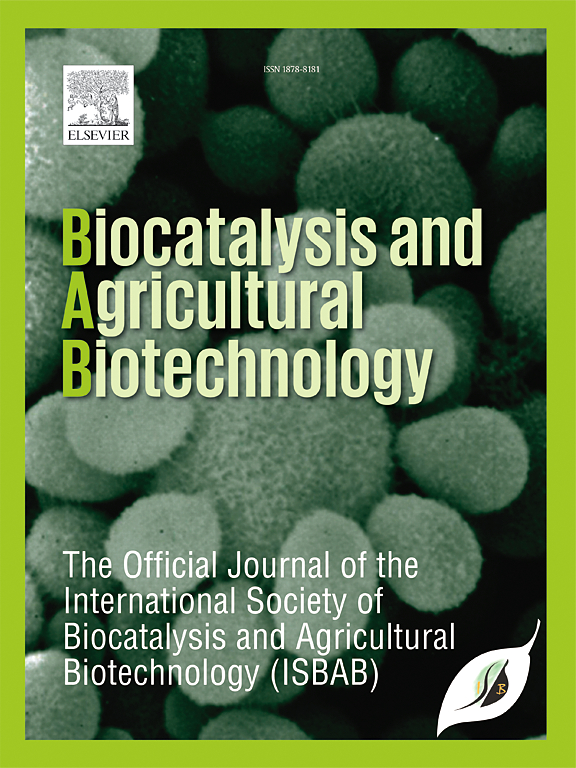Biogenic synthesis of Albizia lucidior mediated magnetite nanoparticles (Fe3O4 NPs): Therapeutic applications and photocatalytic activity
IF 3.8
Q2 BIOTECHNOLOGY & APPLIED MICROBIOLOGY
引用次数: 0
Abstract
This study presents the biogenic synthesis of magnetite (Fe3O4) nanoparticles using Albizia lucidior ethanolic leaf extract, a novel green approach leveraging the plant's rich phytochemical profile, including phenols (157.37 ± 1.69 mg GAE/g), flavonoids (224.65 ± 1.74 mg QE/g), and terpenoids (231.08 ± 1.90 mg LNE/g) for the first time. Characterization techniques of nanoparticles, including XRD, FTIR, UV–Vis, AFM, FESEM and EDX were performed. FESEM and XRD confirmed the formation of spherical NPs with a crystallite size of 12.28 nm. The NPs exhibited significant antioxidant activity (DPPH scavenging: 64.55 ± 0.49 %; metal chelation: 73.77 ± 0.6 %) and demonstrated cytotoxic effects against HeLa (45.11 ± 1.4 %) and MCF-7 (53.88 ± 0.6 %) cell lines. Photocatalytic studies revealed 60.32 % degradation of sunset yellow dye by NPs under sunlight. The phytotoxicity assays indicated a growth-stimulating effect on Vigna radiata seeds. These significant findings underscore the potential of A. lucidior mediated Fe3O4 NPs as innovative nano-formulation, offering mechanistic insights into therapeutic actions, while also serving as effective tools for environmental protection through effective pollutant degradation.

lucidia介导的磁铁矿纳米颗粒(Fe3O4 NPs)的生物合成:治疗应用和光催化活性
本研究首次利用绿足苜蓿丰富的植物化学成分,包括酚类物质(157.37±1.69 mg GAE/g)、黄酮类物质(224.65±1.74 mg QE/g)和萜类物质(231.08±1.90 mg LNE/g),利用绿足苜蓿乙醇叶提取物生物合成纳米Fe3O4。采用XRD、FTIR、UV-Vis、AFM、FESEM、EDX等表征方法对纳米颗粒进行表征。FESEM和XRD证实形成了晶粒尺寸为12.28 nm的球形NPs。NPs具有显著的抗氧化活性(DPPH清除率:64.55±0.49%;金属螯合:73.77±0.6%),对HeLa(45.11±1.4%)和MCF-7(53.88±0.6%)细胞株具有细胞毒作用。光催化研究表明,NPs在日光下对日落黄染料的降解率为60.32%。植物毒性试验表明,该物质对紫荆种子有刺激生长的作用。这些重要的发现强调了lucidior介导的Fe3O4 NPs作为创新纳米制剂的潜力,提供了治疗作用的机制见解,同时也通过有效的污染物降解作为环境保护的有效工具。
本文章由计算机程序翻译,如有差异,请以英文原文为准。
求助全文
约1分钟内获得全文
求助全文
来源期刊

Biocatalysis and agricultural biotechnology
Agricultural and Biological Sciences-Agronomy and Crop Science
CiteScore
7.70
自引率
2.50%
发文量
308
审稿时长
48 days
期刊介绍:
Biocatalysis and Agricultural Biotechnology is the official journal of the International Society of Biocatalysis and Agricultural Biotechnology (ISBAB). The journal publishes high quality articles especially in the science and technology of biocatalysis, bioprocesses, agricultural biotechnology, biomedical biotechnology, and, if appropriate, from other related areas of biotechnology. The journal will publish peer-reviewed basic and applied research papers, authoritative reviews, and feature articles. The scope of the journal encompasses the research, industrial, and commercial aspects of biotechnology, including the areas of: biocatalysis; bioprocesses; food and agriculture; genetic engineering; molecular biology; healthcare and pharmaceuticals; biofuels; genomics; nanotechnology; environment and biodiversity; and bioremediation.
 求助内容:
求助内容: 应助结果提醒方式:
应助结果提醒方式:


